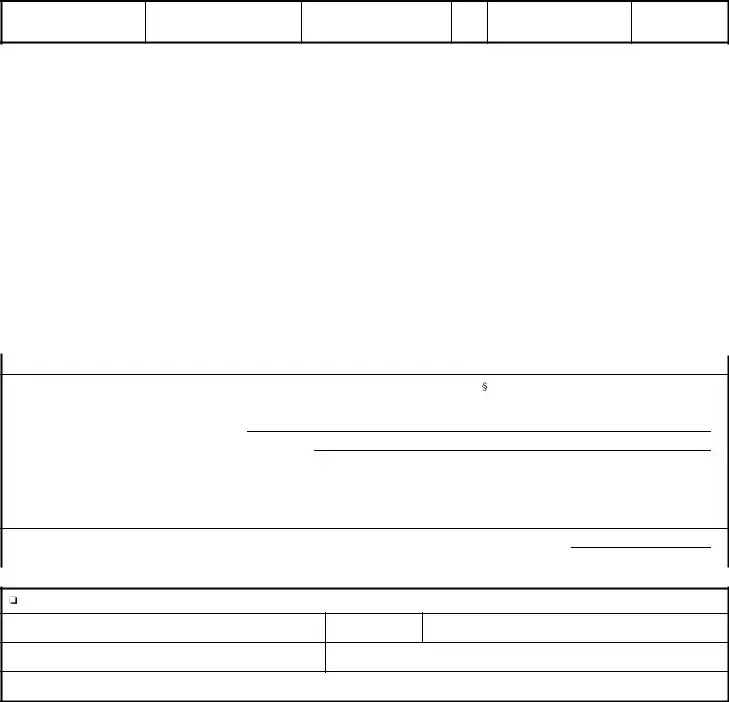WC-104 NOTICE TO EMPLOYEE OF MEDICAL RELEASE TO RETURN TO WORK WITH RESTRICTIONS OR LIMITATIONS
GEORGIA STATE BOARD OF WORKERS' COMPENSATION
NOTICE TO EMPLOYEE OF MEDICAL RELEASE TO RETURN TO WORK
WITH RESTRICTIONS OR LIMITATIONS
Instructions: The employer shall use this form to notify an employee that the authorized treating physician has released the employee to return to work with restrictions or limitations, as required by O.C.G.A. §34-9-104(a) and Board Rule 104. This form, with attached medical report, must be sent to the employee and counsel for the employee, within 60 days of the release to return to work. This form, along with attached medical report, should only be filed with the Board as an attachment to a Form WC-2 when converting benefits from TTD to TPD.
|
|
|
A. IDENTIFYING INFORMATION |
|
|
|
County of Injury |
|
|
INSURER/ |
Name |
|
|
EMPLOYEE |
|
|
|
|
|
|
|
|
|
SELF-INSURER |
|
|
|
|
|
|
|
|
|
|
|
|
|
|
|
|
|
|
Address |
|
|
|
Name |
|
|
|
|
|
|
CLAIMS OFFICE |
|
|
|
|
|
|
|
|
|
|
City |
State |
Zip Code |
Address |
|
|
|
|
|
|
|
|
|
|
E-mail |
|
|
|
|
|
|
|
|
|
|
|
|
|
|
|
|
|
|
City |
|
State |
Zip Code |
|
Name |
|
|
|
|
|
|
EMPLOYER |
|
|
|
|
|
|
|
|
|
|
|
SBWC ID# (five digit no.) |
|
Insurer/Self-Insurer File # |
Address |
|
|
|
|
|
|
|
|
|
|
|
|
|
City |
State |
Zip Code |
Phone Number |
|
|
|
|
|
|
|
|
|
|
E-mail |
|
|
E-mail |
|
|
|
|
|
|
|
|
|
|
|
|
|
|
|
|
|
|
|
B. NOTICE TO EMPLOYEE
1.Your injury, which occurred on or after July 1, 1992, is not catastrophic, as defined in O.C.G.A. 34-9-200.1(g).
2.You are receiving income benefits, and are not working.
3.Your authorized treating physician, who is
has released you to work with restrictions or limitations on
4.The limitations from the physician are as follows:
A copy of the physician's report, which authorizes your release and describes your limitations, is attached.
5.Because you have been released to return to work with restrictions, your income benefits will be reduced from $
|
per week to $ |
|
per week on |
|
, unless you return to work at an earlier date. |
|
I certify that I have today sent a copy of this form with the attached medical report to the employee and counsel for the employee, if represented.
E-mail
IF YOU HAVE QUESTIONS PLEASE CONTACT THE STATE BOARD OF WORKERS’ COMPENSATION AT 404-656-3818 OR 1-800-533-0682 OR VISIT http://www.sbwc.georgia.gov
WILLFULLY MAKING A FALSE STATEMENT FOR THE PURPOSE OF OBTAINING OR DENYING BENEFITS IS A CRIME SUBJECT TO PENALTIES OF UP TO $10,000.00 PER VIOLATION (O.C.G.A. §34-9-18 AND §34-9-19).
WC-104 |
REVISION . 07/2011 |
104 |
NOTICE TO EMPLOYEE OF MEDICAL RELEASE TO |
RETURN TO WORK WITH RESTRICTIONS OR LIMITATIONS |
